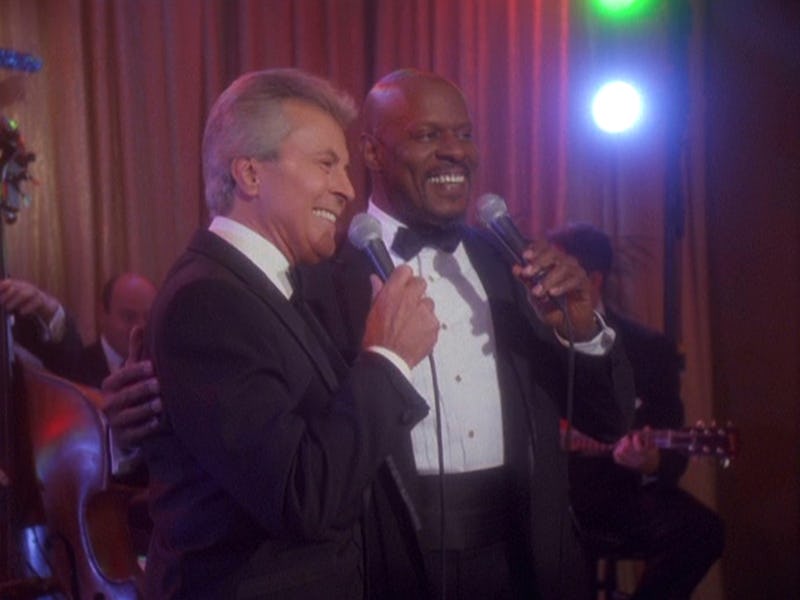How James Darren’s Vic Fontaine Gave Deep Space Nine Its Heart
Darren’s penultimate appearance on Deep Space Nine was special in more than one way.

At the age of 88, James Darren has sadly passed away. For science fiction fans, Darren is probably most memorable for his role as Tony Newman in the epic 1966 sci-fi series The Time Tunnel — a show that blazed the trail for all other time travel shows before and since. Just kidding. As wonderful and tragically underrated as The Time Tunnel is, the most famous science fiction role James Darren ever played was easily that of Vic Fontaine, the holographic — and thus, AI — lounge singer from Star Trek: Deep Space Nine.
With Darren’s passing, Trek fans, actors and writers alike are all sharing their memories of Darren both in real life and, of course, as Vic on DS9. While Vic didn’t show up until season 6 and only appears in eight episodes total, his impact on DS9 was massive. Hardcore DS9 people will correctly tell you that the episode “It’s Only a Paper Moon” is a poignant tear-jerker, or that the debut Vic episode “His Way” is a perfect origin story. These assessments would be correct. But the most quintessential Vic episode has got to be the 1999 season 7 banger, “Badda-Bing, Badda-Bang.” Here’s why you should rewatch it right now.
The Importance of Being Vic
Vic Fontaine (James Darren) sings his heart out.
Created as an amalgamation of Frank Sinatra, Bing Crosby, and Tom Jones, Vic Fontaine’s intentionally anachronistic vibe was less about Boomer nostalgia and more about creating a counterpoint to some of DS9’s heavier themes. Because the struggle against the Dominion occupied much of the overarching narratives of the show’s final two seasons, Vic and his swinging lounge act allowed the grittiest and darkest of the Trek shows some breathing room from time to time. This fact alone is probably why it seems like Vic is in the series more than he actually is; the moments where the crew stopped to pause and have a good time at Vic’s inform everything else that came before and after.
Although the DS9 team initially sought both Tom Jones and Robert Goulet for the part, it's impossible now to think of anyone but Darren in the role. Part of this is because Darren smartly doesn’t oversell the schtick. Yes, he’s a Sinatra-esque hologram, but don’t worry about it, baby. In fact, the idea that Vic was aware he was a hologram and that he existed in the 24th century was one of the smarter aspects of the character. Instead of having him be flummoxed by the future jargon, he just rolled with it. In some ways, this was the evolution of the holographic Professor Moriarty from The Next Generation, only with a more upbeat spin. Vic quickly became a confidant and giver of advice to the weary crew of the titular space station, which is why, when the chips were down for him, the crew had to pay back the favor.
Saving Vic Fontaine
The crew heads for the holosuite, ready for the heist in “Badda-Bing, Badda-Bang.”
Like the android Data from The Next Generation or the holographic Doctor from Voyager, the invention of Vic Fontaine for Deep Space Nine represents the Star Trek franchise’s cautious optimism when it comes to self-aware AIs. Generally speaking, when a sentient AI in Star Trek is connected to a hivemind, or has massive amounts of power and control over a big network, it’s bad. But, when AIs are fire-walled in limited environments, or, mostly analog (like Data), we’re told they’re okay.
“Badda-Bing, Badda-Bang” plays with these stakes in a novel way: Vic’s program runs somewhat autonomously, but his world is basically a pre-programmed game, in which obstacles in the virtual world can destroy him forever. And so, when holographic gangsters threaten to run Vic out of town, the stakes for him are utterly real. Turns out the programmer of this simulation added a feature in which Vic can be permanently erased if this scenario isn’t rectified. The closest analog to this in our world would be the phenomenon in which digital pets can go hungry and never be brought back to life.
But, because of Darren’s wonderful layered performance as Vic, we never believe he’s like a digital pet. Instead, his status as an AI in a fake nightclub is taken somewhat seriously by the entire crew. That is, except for Captain Sisko (Avery Brooks), who makes an excellent point that the fantasy of Vic’s ignores the real 1960s reality that racial segregation was still happening. In one of Deep Space Nine’s smartest scenes, Sisko and Kasidy Yates (Penny Johnson Jerald) debate on the ethics of an anachronistic fantasy that problematically overlooks historical truths for the sake of fun.
In a sense, the version of Vic’s lounge that the evil AI mobsters want to create is probably closer to reality than the nice, laid-back more squeaky-clean version our Star Trek regulars are used to. When Sisko agrees to help be part of the Ocean’s 11-style heist to take by Vic’s nightclub, he’s doing it because he realizes the fantasy of Vic’s is better than the reality of whatever horrible version is about to replace it.
And it’s there that “Badda-Bing, Badda-Bang” becomes a deeply profound Star Trek episode, even though it seems to be one of the sillier entries. While fighting for their survival against enemies on all sides, our Starfleet heroes decided that wouldn’t let their comforting fantasy be murdered. As Avery Brooks and James Darren sing “The Best is Yet to Come” at the end of the episode, you kind of know that not every aspect of DS9 will result in a happy ending. But for that one moment, the fantasy felt good, and in that fantasy, there was healing.